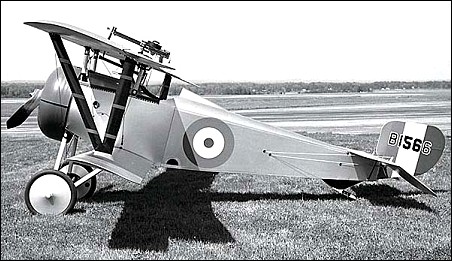|
| There is no text information for this aircraft at the moment.
| MODEL | N.17bis |
| CREW | 1 |
| ENGINE | 1 x 130hp Clerget 9B |
| WEIGHTS |
| Take-off weight | 555 kg | 1224 lb |
| Empty weight | 375 kg | 827 lb |
| DIMENSIONS |
| Wingspan | 8.22 m | 27 ft 12 in |
| Length | 6.01 m | 20 ft 9 in |
| Height | 2.60 m | 9 ft 6 in |
| Wing area | 15.00 m2 | 161.46 sq ft |
| PERFORMANCE |
| Max. speed | 174 km/h | 108 mph |
| Cruise speed | 158 km/h | 98 mph |
| Ceiling | 5600 m | 18350 ft |
| Rate of climb | 357 m/min | 1150 ft/min |
| Range | 250 km | 155 miles |
| ARMAMENT | 1 x 7.7mm |
| Klaatu83, e-mail, 06.07.2013 17:24 The lower wing was made narrow in order to improve downward visabilty for the pilot. However, the fact that it had only a single main spar, which was the reason for the characteristic "V-Strut" arrangement, made the lower wing liable to twist in flight, and rendered it structurally weaker than a conventional two-spar wing. In Germany, Albatros copied the Nieuport wing configuration in their D-III and D-V fighters, and the same inherent structural weakness carried over into them as well.
The Nieuport "V-Strutters" were very light and maneuverable, but the inherent structural weakness of their wing design could not be carried over safely into larger and more powerful airplanes. In 1918 The Americans did use Nieuport fighters, but they were the newer and more powerful Nieuport 28 model, in which the single-spar "V-Strut" wing had finally been abandoned. reply | | BrianTJohnston, e-mail, 24.07.2012 18:25 The Nieuport 17 'Superbebe' was a development of the Nieuport 11. In the photo it is shown with its original armament of a Lewis gun over the top wing, but later models were equipped with a synchronised Vickers gun firing through the propellor arc. It could easily outclimb and outperform the Fokker E.III, to the extent that the German high command ordered it to be copied, leading to the Albatros D.III. The weakness with the wings which Anna mentions was due to the design of the stuts. Where normally there were a parallel pair of struts connecting the two wings, on this aircraft, due to the narrowness of the lower wing, the two struts were connected to a single point on the lower wing, thus allowing the wing to twist much more than normal, especially when diving.
Brian reply | | Anna Kreisling KG-200, 29.06.2011 01:29 This famous French Fighter inspired the German Albatross firm to produce the Albatross D-3. The Albatross D-2 was good and it was the first fighter that Manfred Von Richthoven first flew. However the French and the British came up with two fighters that stunned the German designers. One was the Nieuport that you are now seeing, the other was the Sopwith Triplane. Manfred Von Richthoven scored most of his victories flying the Albatross D-3, which also had the same weakness as the Nieuport. If you panicked in a dogfight and went into a full power dive, you could tear the wings off your fighter. In 1917 many Americans were given the Nieuport to fly, but by 1918 the really hot French fighter was the SPAD. reply | | xxz, 26.06.2011 17:54 IT'S A PITY THAT THERE'SNO MESSAGE ABOUT THIS FAMOUS FIGHTER...... reply |
|
Do you have any comments?
|
| 
All the World's Rotorcraft |











